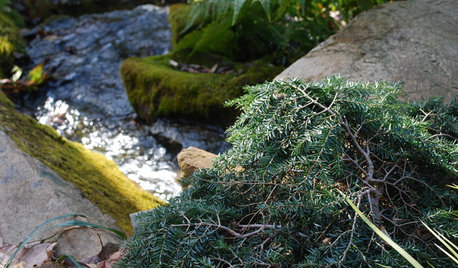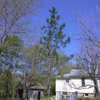what happened with canadian hemlocks
mikesin
12 years ago
Related Stories

EXTERIORSModern Canadian Homes Showcase Clever Entryways
From hidden doors to sculptural steps, the entrances to these Ontario, Canada, dwellings make homecoming a special pleasure
Full Story
PATIO OF THE WEEKWater and Fire Mingle in a Canadian Front Yard
If the illuminated moat winding through this Ontario patio doesn't dazzle you, the 8-foot-wide fireplace will
Full Story
HOUZZ TOURSHouzz Tour: Wide-Open Views on a Narrow Canadian Lot
Expansive glass walls facing the street create openness, sun-filled rooms and closer relations with the neighbors
Full Story
HOUZZ TOURSHouzz Tour: Open, Airy Canadian Bauhaus Home
Built for entertaining and maximizing natural light, an Edmonton home incorporates sunrooms, screens and easy access to the outdoors
Full Story
GARDENING GUIDESGreat Design Plant: Tsuga Canadensis ‘Bennett’
Bennett Canadian hemlock thrives in shade and provides sculptural interest in eastern U.S. gardens
Full Story
TRAVEL BY DESIGNTravel Guide: Vancouver for Design Lovers
You'll find more than just great architecture in this diverse coastal Canadian city — terrific parks, shops, eateries and museums abound too
Full Story
HOUZZ TOURSMy Houzz: Travel, Art and Creative Layering Mix in Vancouver
Personality reigns in this eclectic Canadian waterfront home, thanks to the owners' artistic approach
Full Story
HOUZZ TOURSHouzz Tour: Mixing It Up in a Century-Old Edwardian
Different eras, patterns and textures mingle beautifully in a Canadian interior designer's home and 'design lab'
Full Story
KITCHEN DESIGNKitchen of the Week: Budget-Friendly Boosts in Toronto
Blandness gets the boot as a Canadian kitchen receives a bold dose of color and custom cost-conscious storage
Full Story
GREEN BUILDINGHouzz Tour: Going Completely Off the Grid in Nova Scotia
Powered by sunshine and built with salvaged materials, this Canadian home is an experiment for green building practices
Full StoryMore Discussions








monkeytreeboy15
tsugajunkie z5 SE WI ♱
Related Professionals
Ballwin Landscape Architects & Landscape Designers · Prairie Ridge Landscape Architects & Landscape Designers · Brookside Landscape Contractors · Barrington Landscape Contractors · Beverly Hills Landscape Contractors · Hampton Bays Landscape Contractors · Hicksville Landscape Contractors · Huntley Landscape Contractors · Las Vegas Landscape Contractors · Painesville Landscape Contractors · Salem Landscape Contractors · San Rafael Landscape Contractors · Camp Springs Landscape Contractors · Shafter Landscape Contractors · East Cleveland Gardeners & Lawn Carekarate626
tsugajunkie z5 SE WI ♱
Embothrium
davidrt28 (zone 7)
mikesinOriginal Author
baxswoh
pineresin
baxswoh
in ny zone5